Let’s look at some incredible Caracal facts. Caracals (Caracal Caracal) are very striking cats. They have uniform reddish brown fur and black ear tufts. Some reports of black caracals have surfaced, but this is an exception. Their standard color is anything from tawny to brick red. Caracals are the largest of Africa’s small cats. They are robust and imposing, with males weighing up to 40 pounds. Females are usually smaller and can weigh up to 35 pounds. These beautiful felines grow to heights of between 16 and 20 inches, with body lengths reaching between 35 and 39 inches.
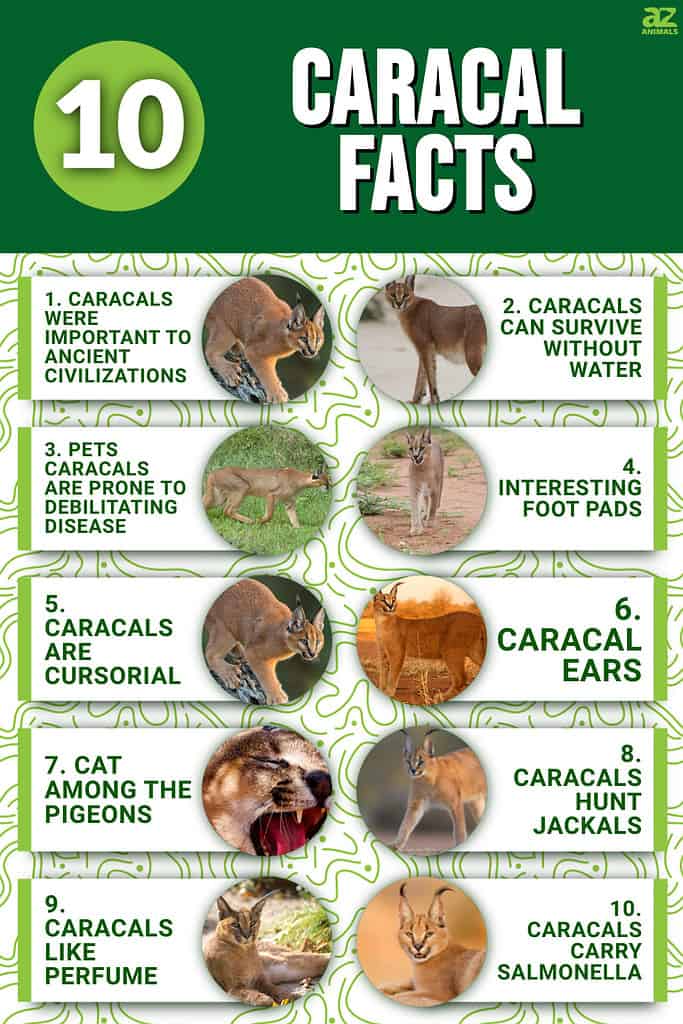
1. Caracals Were Important to Ancient Civilizations
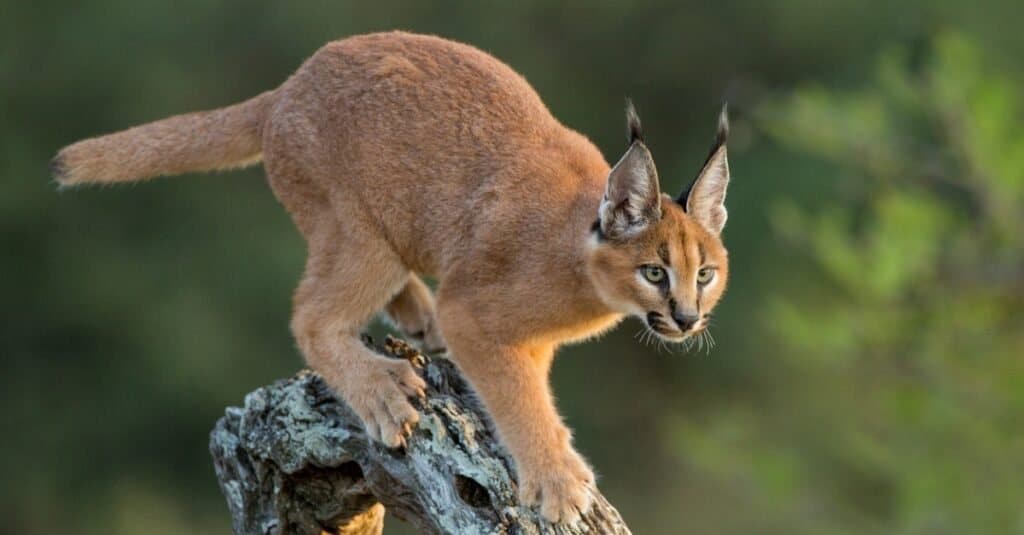
Caracals are easy to identify because of their unusual ears with long, hairy tufts.
©iStock.com/StuPorts
In ancient Egypt, caracals escorted the Egyptian god Mafdet and the goddess of war, Pakhet. Gilded statues of caracals protected the tombs of pharaohs and other high-ranking individuals. Both Egyptian and Indian royalty reportedly tamed caracals and used them for hunting. Hunting game birds with caracals was another popular activity in certain ancient civilizations.
A 4,000-year-old hunting scene depicts them decorating many Egyptian tomb walls. For example, one famous portrayal is of a painting decorating the tomb of Vizier Khnumhotep III. Archeologists have also discovered old images in India and Persia of hunting scenes, including the caracal. These ancient civilizations preserved some of their histories, giving us a glimpse into their world. Now, we can better understand the caracal’s relationship with our predecessors.
Additionally, in ancient China, it wasn’t uncommon for the Royal family to use caracals as gifts. For instance, royal members of the Yuan dynasty from the 13th and 14th centuries gave caracals to other royal families as gifts. They were also well known for buying caracals, cheetahs, and tigers from Muslim traders to keep as pets.
2. Caracals Can Survive Without Water

Caracals also use areas of their habitat that other cats neglect because they do not need a constant water supply.
©Derek Keats from Johannesburg, South Africa, CC BY 2.0 – License
Caracals typically inhabit arid areas with scarce water sources. These cats can occupy such regions because they have adjusted their ability to absorb sufficient fluids from their prey. Also, they have adapted to only release concentrated drops of urine to preserve their hydration levels. Caracals also use areas of their habitat that other cats neglect because they do not need a constant water supply.
Caracals live in Central, South, and West Africa, as well as in Southwest Asia and the Middle East. The name caracal comes from the Turkish words ‘Kara kulak’, which means ‘black ear.’ Caracals are an endangered species in India, where only a few individuals live in the wild. Additionally, their numbers in South Africa are under speculation. Farmers and villagers often regard them as nuisance animals for preying on livestock, so they trap and hunt them for this reason. Caracals prefer drier Savannah areas of sub-Saharan Africa when allowed to roam free.
3. Pets Caracals Are Prone To Debilitating Disease
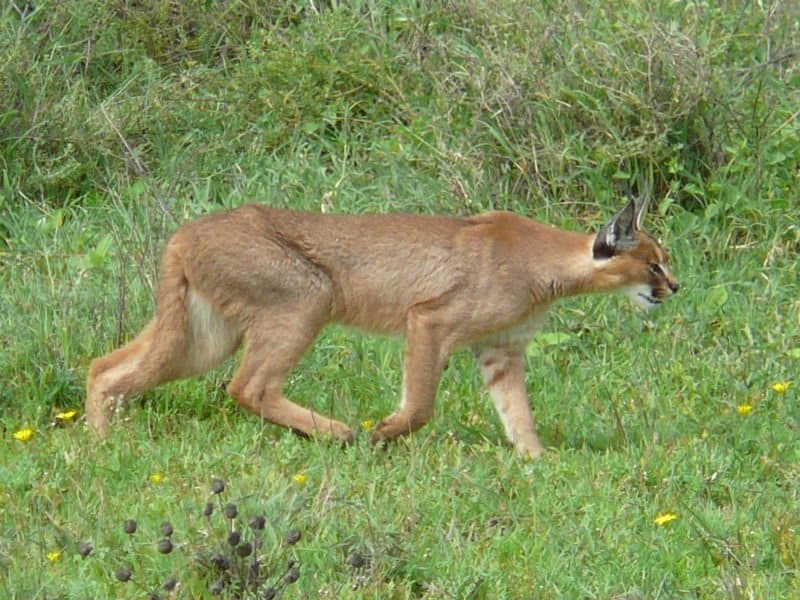
Caracal in the Serengeti
©Nick and Melissa Baker / CC BY 2.5 – License
In some areas of the world, it is common to keep caracals or other exotic animals as pets. Unfortunately, this culture has a downside for the animal. Caracals are carnivores and need approximately three pounds of raw meat daily. These cats often eat the whole prey, including the flesh, skin, and bones. Bones are an essential source of much-needed nutrients like calcium and magnesium. Caracals can develop Metabolic Bone Disease (MBD) when they do not receive appropriate diets. This disease develops when caracals (or any big exotic cat, for that matter) receive insufficient nutrition from their diets.
Metabolic Bone Disease develops when the cat’s body takes calcium from its bones. Their bodies automatically compensate for poor diets to maintain and support critical functions. Signs of MBD include lameness, bowed front legs, and cats that are smaller than they should be. MBD can be fatal, and pet caracals are usually euthanized if the disease is too severe. Pet caracals can also develop amyloidosis. This disease causes a build-up of the amyloid protein, resulting in renal failure and death.
4. Interesting Foot Pads
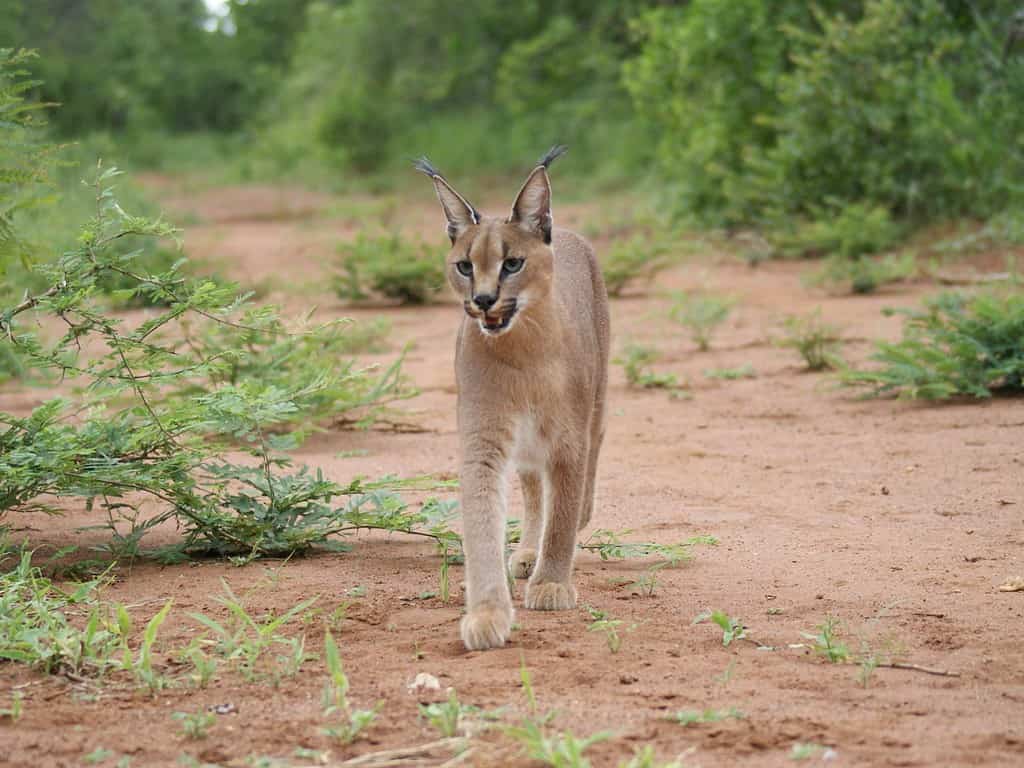
The benefit of hair between their footpads also enables them to stalk their prey in silence.
©Louise Joubert, CC BY-SA 3.0 – License
Caracals have long stiff hairs between the pads of their feet. This adaptation allows them to walk on the soft sand on the outskirts of the Saharan and Arabian deserts. The benefit of hair between their footpads also enables them to stalk their prey in silence.
5. Caracals Are Cursorial

Caracals can run at speeds of 50 mph. These wild cats are easy to identify because of their unusual ears with long, hairy tufts.
©iStock.com/StuPorts
Cursorial animals have adapted the ability to run well and fast for long periods. Caracals can run at speeds of 50 mph. Swiftness and their special foot pads make the caracal an exceptional runner.
6. Caracal Ears
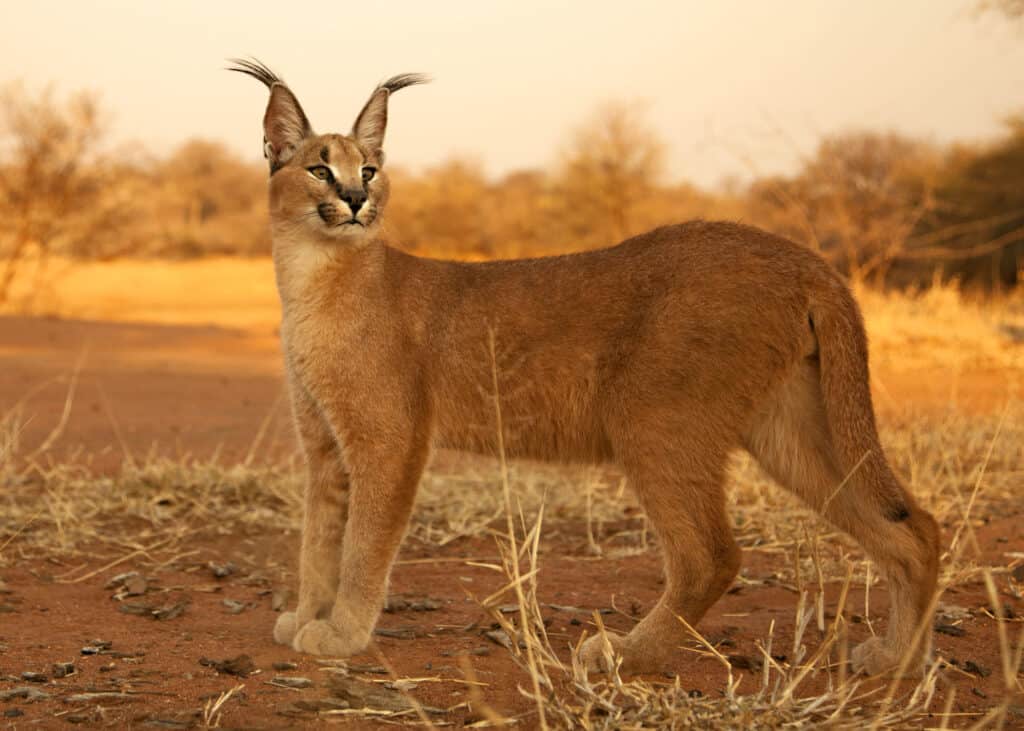
Caracals use their ears to locate prey more easily, making them exceptional hunters.
©iStock.com/MarieHolding
Caracals have unique ears comprising 20 muscles for superior control. These animals can turn their ears in various directions to identify sounds and distances. Because of this superpower, caracals use their ears to locate prey more easily, making them exceptional hunters. Scientists don’t know much about the function of the caracal’s long black ear tufts. However, they believe that these tufts function much like whiskers. Whiskers help cats identify obstacles and evaluate distances, supporting their ability to hunt silently.
7. Cat Among the Pigeons
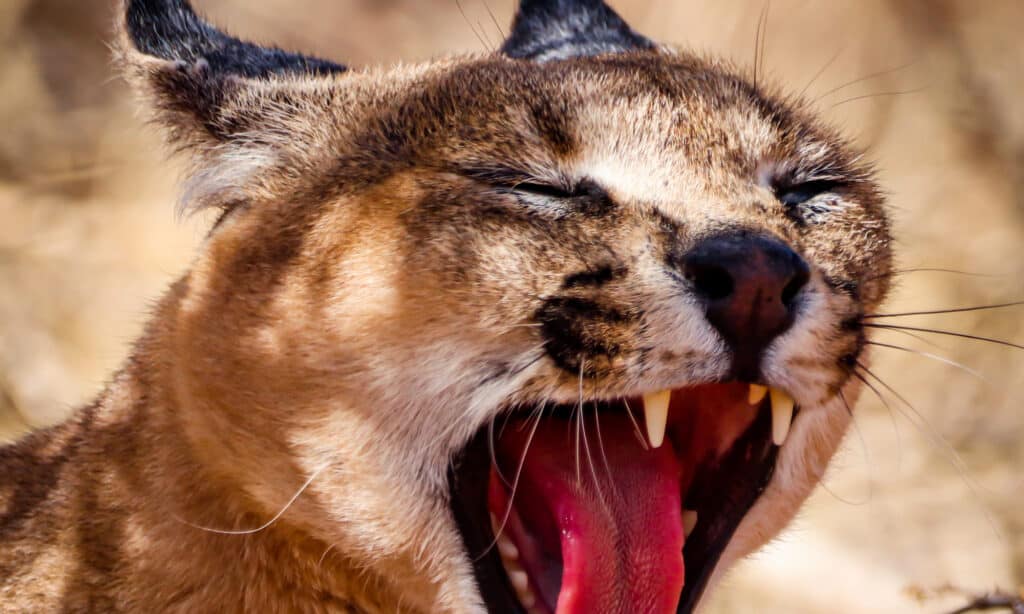
Humans trained caracals to help them hunt in ancient India and Iran.
©Steffen Travel/Shutterstock.com
Ever heard the expression ‘let the cat out among the pigeons? The caracal is likely to be the origin of the term. Humans trained caracals to help them hunt in ancient India and Iran. They considered it an excellent sport to release these trained caracals in arenas, usually with flocks of pigeons. The number of birds the caracal would kill in one leap became the subject of many exciting wagers.
8. Caracals Hunt Jackals
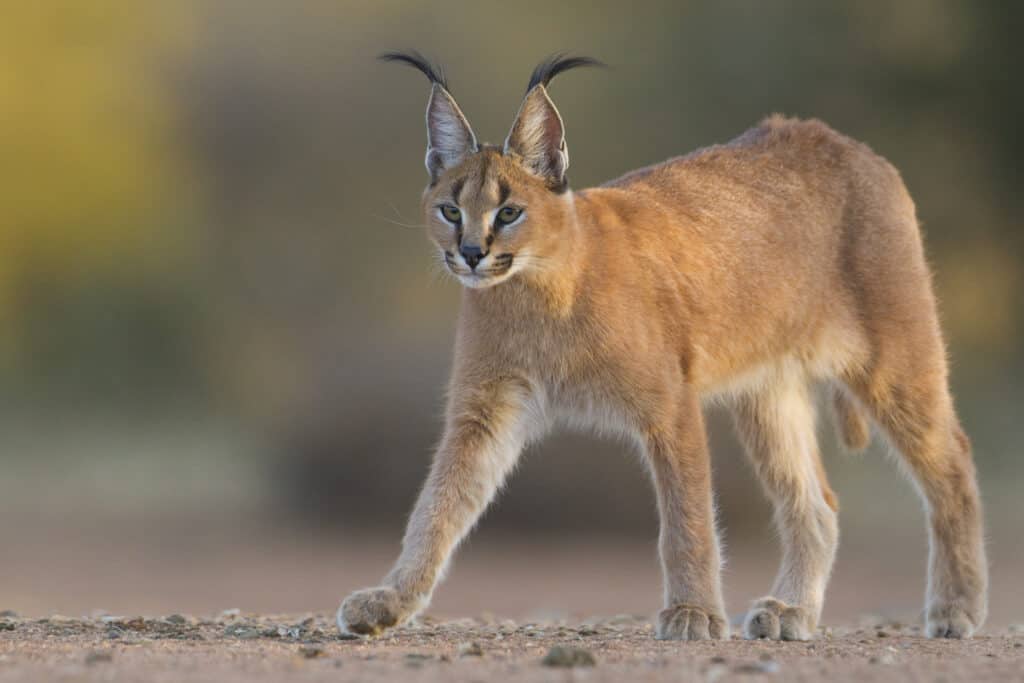
Humans trained caracals to help them hunt in ancient India and Iran.
©iStock.com/StuPorts
Scientists conducted studies in the Kgalagadi Transfrontier Park. They analyzed scat samples showing that caracals hunted black-backed jackals. These jackals are at the highest end of the prey spectrum, so finding evidence was rare. Besides, this study also proved that most caracal prey animals were small. They were the size of small mice, ground roosting birds, and even small domestic livestock, except for the black-backed jackal.
9. Caracals Like Perfume
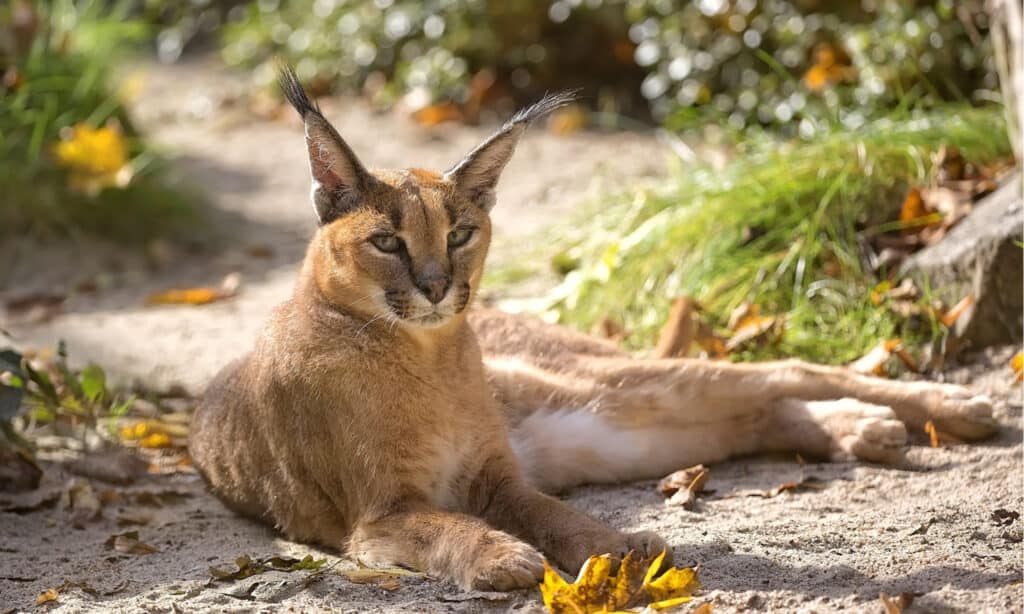
Scientists sprayed rocks with various scents and both leopards and caracals rubbed their cheeks against the rocks, expressing their interest in these scents.
©Janusz Pienkowski/Shutterstock.com
A 2013 study conducted in the Southern Cape showed surprising results. It demonstrated how caracals and leopards reacted to rocks sprayed with human-made perfume. Scientists sprayed rocks with various scents such as Lentheric’s, I Love Vanilla, Junique, and Dolce & Gabbana’s, The One. Both leopards and caracals rubbed their cheeks against the rocks, expressing their interest in these scents.
10. Caracals Carry Salmonella
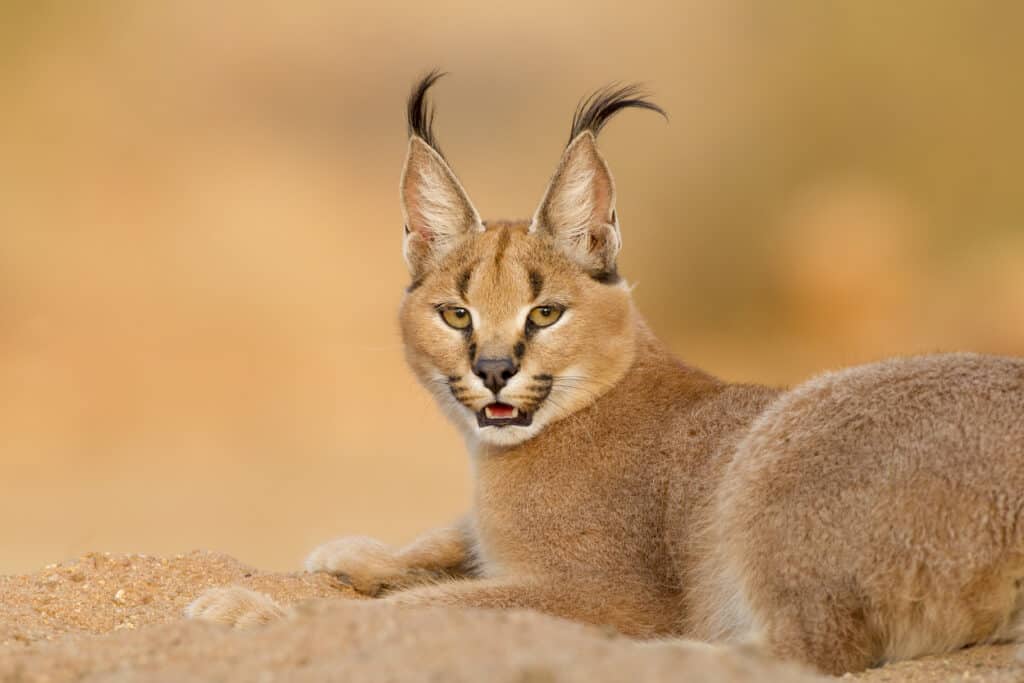
The soft padding of Caracal paws allows them to walk on the soft sand on the outskirts of the Saharan and Arabian deserts.
©iStock.com/StuPorts
A 1997 study on fecal samples of captive caracal and other cats tested positive for salmonella. These cats were all housed separately and fed horsemeat and chicken. Then, scientists collected fecal samples. Their research proved that all the fecal samples contained salmonella, a dangerous bacterium. Consequently, scientists advised zoo employees to take the necessary precautions to reduce their exposure to this bacterium.
The photo featured at the top of this post is © iStock.com/StuPorts
Sources
- Tiger Haven, Available here: http://www.tigerhaven.org/reference/files/Clyde%20Salmonella%20carriage%20in%20cat%20JZWM.pdf
- Academia.edu, Available here: https://www.academia.edu/25689554/Observations_of_leopard_and_caracal_responses_to_novel_scents_in_South_Africa
- Academia.edu, Available here: https://www.academia.edu/57539853/Prey_selection_by_caracal_in_the_Kgalagadi_Transfrontier_Park_research_article
- SafariBookings, Available here: https://www.safaribookings.com/blog/facts-about-the-caracal
- Animalia, Available here: https://animalia.bio/caracal#facts
- ResearchGate, Available here: https://www.researchgate.net/publication/229890740_What_is_a_cursorial_mammal
- National Library of Medicine, Available here: https://pubmed.ncbi.nlm.nih.gov/32212564/
- Animal and Plant Health Inspection Service, Available here: https://www.aphis.usda.gov/animal_welfare/downloads/dangerous-animals/ACaids_BigCats2_4.19_AC-18-018.pdf
- The Arena Media Brands, Available here: https://owlcation.com/stem/Caracal-Adaptations-and-Facts
- JustFunFacts, Available here: http://justfunfacts.com/interesting-facts-about-caracals/
- ResearchGate, Available here: https://www.researchgate.net/publication/316165520_Focus_on_the_Caracal_Lynx_Caracal_caracal
- Coffee and Creatures, Available here: https://coffeeandcreatures.co.uk/2018/09/25/caracal/
Thank you for reading! Have some feedback for us? Contact the AZ Animals editorial team.






